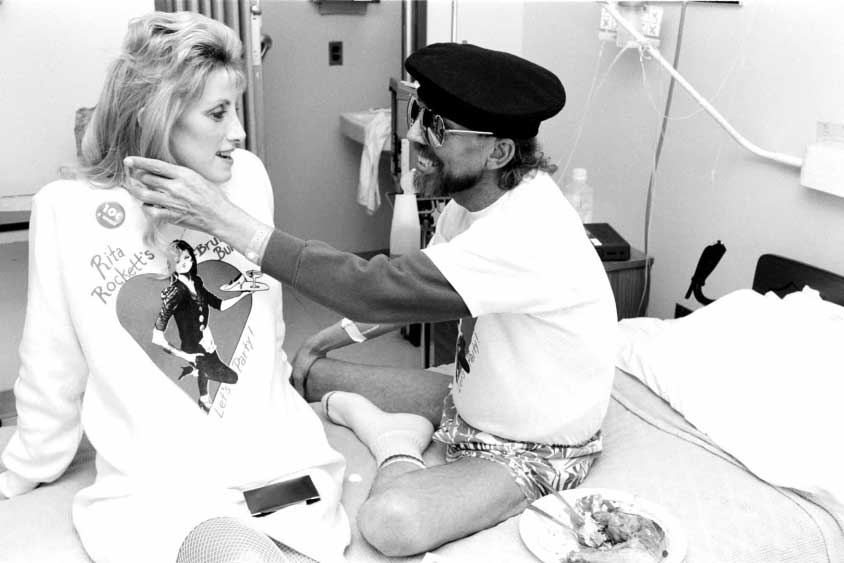The compassionate documentary “5B” is named for the first AIDS ward, which opened on July 25, 1983, at San Francisco General Hospital.
This film, opening at area theaters June 14, recounts the experiences of various nurses, doctors and patients through candid, moving interviews about the fears, tragedies and occasional triumphs that took place in the ward during the height of the AIDS epidemic.
Directors Paul Haggis and Dan Krauss also lay bare the hatred and homophobia of the time, when some doctors and nurses at the hospital fought against care and protection for AIDS patients, stirring media, politics and even labor issues.
The film begins in the 1970s, when gay men and women in San Francisco were experiencing sexual freedom. Of course, everything changed in 1981 when the first AIDS cases were reported. Suddenly, hospitals like SF General were overwhelmed with patients suffering from a disease that was too new to understand and instilled fear in caregivers.
To care for an AIDS patient in the early days was considered “dirty nursing,” according to one interviewee. Doctors and nurses would don “spacesuits” so as not to risk infection.
Moreover, most patients with AIDS were marginalized or ostracized and treated with disgust or disgrace. Many would not receive care until the last minute because no one knew how the disease could be spread, and risk of infection was too great a concern.
However, a team of nurses, including Cliff Morrison, David Denmark, Mary Magee, Sasha Cuttler and Guy Vandenberg, led by Alison Moed Paolercio, along with Dr. Paul Volberding, started a “unique experiment in medical care” at SF General. They created a standard of care in an AIDS ward by caring for patients they could not cure. They touched the men and women who needed to feel human contact when no one would treat them.
These doctors and nurses were allowed to, as one interviewee says, “share the intimate experience of their dying.”
The staff in 5B did some radical things. They let patients define who was family and even permitted animals to be brought — well, smuggled — into the ward on occasion. The emotions these moments generate are empowering and heartfelt, especially in light of the fact that the partners of patients were usually denied visitation rights.
Moreover, parents of the patients often rejected their children for being gay or contracting AIDS. In one of the most poignant sections of the film, the estranged father of a patient is encouraged to tell his dying son how much he loves him to allow him to die with dignity.
As positive as these efforts were, however, there was much fear-mongering as well as nasty infighting within the hospital. Nurses concerned about infection through needle sticks — one nurse, who famously became infected that way, is discussed in the film — did not want to treat people with AIDS. They took their case to the California Division of Labor Standards.
Likewise, Dr. Lorraine Day, an orthopedic surgeon, campaigned for protections, insisting that AIDS patients be tested and/or divulge their condition before she operated on them. Dr. Day’s interviews are particularly infuriating because of the homophobia she spouts.
Another villain in the film is President Ronald Reagan, whose lack of support for the LGBT community is his legacy. Under him, the national budget earmarked for AIDS research was smaller than what the city of San Francisco itself allocated.
But “5B” does feature some upbeat moments, such as scenes of Rita Rockett, who visited the ward as a volunteer to feed and entertain patients.
Out gay local TV reporter Hank Plante has particularly interesting observations about covering the epidemic. He said he was inspired by the courage those living with AIDS displayed when going on air to tell their stories simply to help others cope.
Haggis and Krauss also provide some remarkable footage of the caregivers and patients of the ward. Difficult scenes show medicine being administered or dead bodies wrapped up and carried out, but these powerful images are necessary — a reminder of the daily and weekly experiences in the ward. When one interviewee describes the epidemic surging to overwhelming proportions, the magnitude of their powerlessness is duly felt.
The toll AIDS took, on both the gay community and on the hospital’s doctors and nurses, comes across clearly. When reports surface that protease inhibitors are able to treat the disease, and the film reveals some people with AIDS are surviving, “5B” is optimistic, but signals that the epidemic is not yet over.
This documentary is ultimately life-affirming, showing the resilience of these unsung heroes committed to both a cause and a community — and their efforts to maintain dignity and care above all.
